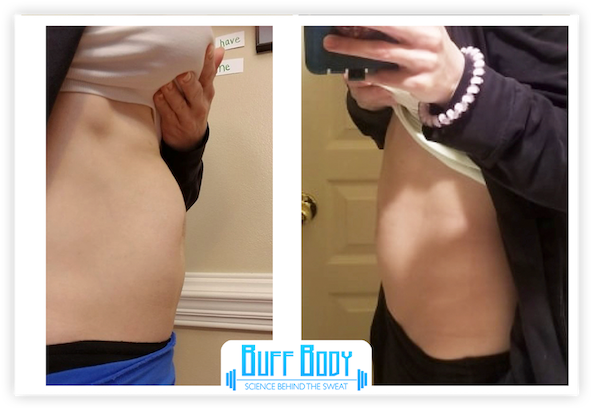Diastasis recti: What it is? How to Fix it?
What is diastasis recti? How do you know if you have it? And how to fix it? In this article by Buff Body, we are going to teach you everything you need to know about this physical condition, and more importantly, how to fix it!
What is diastasis,
Does everyone get diastasis,
When should you take action and can you check if you have diastasis yourself?
Before and after success stories
The best FREE diastasis APP
The answers to these questions and a great postnatal exercise are in this article.
Diastasis, or diastasis recti as it is officially known, does not sound good. But let’s back up for a moment and make sure we all know what a diastasis recti actually is.
Diastasis recti: What it is?
During pregnancy, your abdominal muscles give way to make room for your growing baby. The separation of the straight abdominal muscles (rectus abdominis) at the midline of the connective tissue tendon plate (linea alba) that connects the straight abdominal muscles is called a diastasis.
Diastasis means that the tissue between your straight abdominal muscles, the linea alba, is stretched. You read it correctly: stretched. Your abdominal halves do not tear apart; the linea alba remains intact. Also, no actual hole is made in your abdomen, even though it may feel like one.
If a tear or rupture does occur in the linea alba, we call this an abdominal hernia or abdominal wall rupture.
This stretching is necessary because your baby must be able to grow. A diastasis creates extra space for your baby. You cannot prevent diastasis. And you don't want to, because you want your baby to grow, don't you?
When do you have a Diastasis Recti?
When the space between the left and right halves of your straight abdominal muscles is more than two fingers wide, or when it is very soft, then we speak of diastasis recti. The space between your straight abdominal muscles should feel like a trampoline. When you breathe out and press on it, your fingers should not sink down too deeply. It should feel like pressing on a trampoline: your fingers spring back up.
When the space between your abdominal halves is too large or too slack, you cannot create enough tension there. This can lead to all sorts of complaints: pelvic floor complaints, abdominal pain, complaints of the SI joint or instability. And of course you want to prevent chronic pain as much as possible. Especially if you have to lift your child all day and want to stay active.
How do you know for sure you have a Diastasis Recti?
The most reliable way to find out if you have diastasis is by doing an ultrasound. A pelvic physiotherapist may be able to measure it for you.
You can also test it yourself. It is not difficult at all, but slightly less reliable than an ultrasound. Here is how to do it:
Lie on your back with your knees bent.
Place your fingers across the midline of your abdomen just above and below your navel.
Carefully lift your head off the ground so that your abdominal muscles tighten.
If you feel a bulge or a deep space, you have a diastasis.
VIDEO - Diastasis recti: What it is? How to Fix it?
Recovery after given birth
When you have just given birth, there is often still diastasis. Not only is there still space between the straight abdominal muscles, but you often notice that the muscles of the core do not work well together because of the extra space between the straight abdominal muscles.
This can cause overloading of certain muscle groups and this can lead to, for example, lower back problems, pelvic problems and constipation. It can take up to six months before the core functions optimally again. Should the cooperation of the muscles in the core and the recovery of the diastasis not work by itself, or should complaints arise, it is a good idea to visit a specialised pelvic physiotherapist.
Risk factors for Diastasis
Diastasis during pregnancy in the third trimester is completely normal. However, there are a number of factors that increase the likelihood of extensive diastasis, which may slow down recovery after delivery:
Becoming pregnant after the age of 34
Having given birth before
Caesarean section
Prolonged increased abdominal pressure, for instance due to a superficial breathing pattern or a lot of pushing
Being pregnant with multiple births
A large baby or a lot of amniotic fluid
Incorrect load on the tendon plate during pregnancy causing extra strain on the tendon plate
Constipation
Incorrect strength training during or after pregnancy, causing more strain on the tendon plate
What do you notice when suffering from diastasis?
It can be very unpleasant to have a diastasis, because you can suffer from:
Posture and stabilisation problems, which increase the risk of back and pelvic problems.
Difficulty absorbing abdominal pressure (during coughing, sneezing and pushing), which may lead to problems with breathing and pushing during delivery
Less internal support of the intestines. This can cause problems with defecation
Constipation
An enlarged diastasis during pregnancy increases the risk of a caesarean section
The cosmetic appearance may also change if there is still diastasis after delivery. The belly may remain round, as if you were still several months pregnant. We also call this the mommy-tummy. Should this be the case for you, we recommend that you see a specialist for individual exercises.
Why Fixing Your Diastasis is So Important
Is it important to fix that Diastasis recti apart from just aesthetics? The answer is…yes!
Now, we had a lot of comments and questions on our video about diastasis recti (see video above). And one of the questions that came back a lot is, is it important to fix that such recti apart from just aesthetics? The answer is yes. Because solving your diastasis recti is the key factor to finally get rid of your lower back pain or of your mommy tummy. And there are many more reasons.
What are the possible consequences of diastasis?
Loss of strength: The muscle corset provides support, cushions imbalances and changes movement.
The abdominal muscles support the back when exerting force, give support to the organs and are part of long chains of muscles throughout the body.
Back pain is caused, among other things, by insufficient support of the abdomen at the front of the back. This often results in too much tension in the back muscles. The back then feels stiffer.
Abdominal (muscle) pain
Pelvic complaints
Hip (side) pain
Urinary leakage
Feeling cold in the abdomen
Bowel function disorders
Disruption in proper breathing
Urinary incontinence, often caused by overactive pelvic floor muscles
Neck and shoulder complaints
The consequences of diastasis are very often not recognised…
In our special diastasis app, we have the exercise routine protocol. But apart from that, we have many more features. And one of them is a very extensive video library with everything you need to know about the distances. One example. How can you test your device is recti if you have it or not, and how severe it is.
Why do you want to solve your diocese's recti problem? You want to get rid of your mummy tummy or the bloating of your stomach. But apart from aesthetics, it's got huge consequences for your physical health, because when the facere, the connective tissue in between your both sides of your rectus abdominis is weakened, it allows the belly to go out that way.
You've got less control over your core and allows for a greater hip tilt, which results in an excessive curve from the lumbar spine, which as a consequence puts excessive stress on the intervertebral discs and might, in the long run, even create this bulging or herniation, in worst cases, pinching the nerve, creating back pain that can radiate all the way down to the heel.
Typically, you want to regain control over your abdominals, make them strong, and restore your healthy, neutral spine posture.
Furthermore, an uncontrolled expense is recti is going to be a breach in your power output, as it is the connection between your power producer being legs and hip and the executors, the arms and the hands because your chain of power production is only going to be as strong as the weakest link of that chain. So if the core is weak, the full movement will be compromised.
For instance, your power in a sling, swing or hit is mainly generated in the hip region, but transfers all the way to the hands. And if the core is weak as a result, the movement will also be weak, but also in daily life and work situations. You need the core as a stabilizing freshmen's, for instance, have to take the kid out of the car in much less than ideal circumstances with the weight of the baby being far away from the feet, causing a lot of leverage. Thus a stress on the lower back.
Even the brace is weak. The lower back is in danger. Same story when you want to take heavy objects out of the cupboard or put them in there. And like this, there are many more examples…
The personal trainer in your pocket, especially designed to fix your diastasis recti
Diastasis: Before & After success stories
“Buff Body is LIFE CHANGING. I went from struggling to do daily tasks with my twins to mastering them like a boss. I finally am beginning to feel like myself again.”
Reduced abdominal split from 4 fingers to 3 within 2 weeks
“Great exercises. My diastasis recti was reduced after two weeks and my stomach felt very tight! I finally found someone who could really help me with my diastasis issue!”




